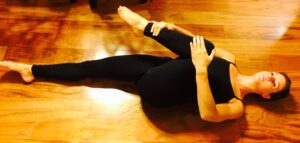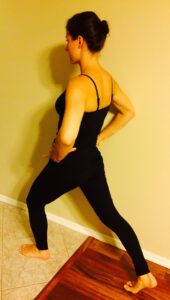3 Stretches Dancers Need to Avoid Injury

PROMOTE BETTER TURNOUT WITH THESE 3 STRETCHES TO AVOID A HIP INJURY
It’s important that the young dancer acquaint herself with safe ways to achieve an efficient turnout. Proper turnout should be achieved with good pelvic alignment and strong core stability.
The pelvis should be in a neutral position—not tilted forward, not fully tucked under—creating a “sway back.” The core needs to be strong in order to maintain and control the movement of the pelvis.
Dancers’ hips tend to be overworked, usually due to compensating for lack of flexibility or strength in the muscles that should be used to maintain turnout. Compensation can present itself in many ways, including using larger muscles such as the gluteus maximus, the biggest buttocks muscle, and the iliopsoas muscle, which can cause a “snapping” sound at the front of the hip if used improperly.
Instead, dancers should learn to first use the deep external rotators to promote a healthier functioning hip joint. The external rotator muscles help to outwardly rotate the femur or thigh bone within the socket of the hip joint. By using these muscles and building the necessary strength and endurance, a dancer’s technique can be greatly improved. T
The hip will maintain a good turnout throughout entire gestures rather than losing turnout mid-gesture and the possibility of hearing or feeling a snap in the front of the hip will be eliminated. That snap is the iliopsoas tendon rolling back and forth across the joint.
Over time, the snapping at the hip can lead to iliopsoas irritation and possible pain. This can be avoided by using the proper muscles and not forcing turnout.
SO…ARE YOU FORCING YOUR TURNOUT?
Stand in your normal first or fifth position:
Do you bend forward at the hips? This action places slack at the front of the hip and makes it easier to force your turnout. This compromises a good, neutral pelvic alignment.
Do you grip the floor with your feet? This can cause misalignment of your knees over your toes which can then lead to knee pain and/or the development of bunions.
When standing in first or fifth, do your feet roll in or pronate? If you have a naturally high arch and it’s gone when you’re in turnout—that’s a sign you’re forcing it.
The next time you’re in class, use your barre warmup as an opportunity to identify if you tend to use the aforementioned no-no’s to force your turnout. It’s better to adjust your turnout to a smaller first and fifth as you learn how stretch and strengthen your true turnout muscles than to force a bigger turnout using improper technique. This will help save your hips in the long run and solidify the proper method to use throughout your dancing career.
Now let’s talk about stretches to promote a healthier hip. These stretches will improve the flexibility around the joint to help allow more movement into turnout.
- Piriformis Stretch: Laying on your back, maintain a neutral spine position. Bend one leg up and across your body, use your arms to pull your knee and foot into your chest, keeping your shoulders square.

- Hip Flexor Stretch: Stand in a wide lunge with your back foot on demi pointe. Keep your hips/pelvis either straight or slightly pushed forward. Bend your front knee slowly until you feel a stretch in the front of the hip of your back leg.

- Internal Rotation Stretch: Lay down on your back. Keep spine in neutral and move your feet away from your body keeping your knees together. You should feel a gentle stretch on theoutside of your hips. If you feel pain in your groin, stop.

Each stretch should be held for at least 30 seconds and performed 2-3 times. It’s a great habit to start performing these easy stretches both before and after class. This way the hip is warm and flexible for class and the tension created in the hip during class is relieved and not held onto afterward.
We hope these common pitfalls and corrective behaviors have given you some insight into how young dancers can achieve proper hip health.
For more information on dancing injuries, call Athletic Physical Therapy or visit these other websites.
Maribeth Crupi, PT is a well known dance medicine based physical therapist in Wilmington, Massachusetts.
The Ballet Blog Lisa Howell is a well known physiotherapist in Sydney, Australia